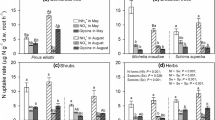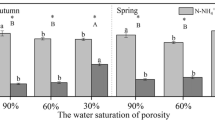Abstract
Background and aims
Nitrogen (N) is one of the most important limiting factors influencing plant growth and reproduction in alpine and tundra ecosystems. However, in situ observations of the effects of root traits on N absorption by alpine plant species are still lacking.
Methods
We investigated the rates of N uptake and the effect of root characteristics in ten common herbaceous alpine plant species using a 15N isotope tracer technique and the root systems of plants growing in a semi-arid steppe environment on the Tibetan Plateau. Our objective was to determine the root traits (root biomass, volume, surface area, average diameter, length, specific root length and specific root area) that make the largest contribution to the total uptake of N (15N–NO3 −, 15N–NH4 + or 15N–glycine) by alpine plant species.
Results
Monocotyledonous species had higher absorption rates for 15N–NH4 +, 15N–NO3 −, 15N–glycine and total 15N than dicotyledonous species (P < 0.05). The root biomass, volume, surface area and average diameter were negatively correlated with the absorption capacity for 15N–NH4 +, 15N–NO3 − and total 15N across the ten alpine plant species. However, the specific root length and the specific root area had significantly positive effects on the uptake of N.
Conclusions
In contrast with traditional views on the uptake of N, the N uptake rate was not improved by a larger root volume or root surface area for these alpine plant species in a high-altitude ecosystem. Root morphological traits had greater impacts on N absorption than traits related to the root system size in alpine herbaceous plants.


Similar content being viewed by others
References
Andersen KM, Turner BL (2013) Preferences or plasticity in nitrogen acquisition by understorey palms in a tropical montane forest. J Ecol 101:819–825
Andresen LC, Jonasson S, Ström L, Michelsen A (2008) Uptake of pulse injected nitrogen by soil microbes and mycorrhizal and non-mycorrhizal plants in a species-diverse subarctic heath ecosystem. Plant Soil 313:283–295
Ashton IW, Miller AE, Bowman WD, Suding KN (2008) Nitrogen preferences and plant-soil feedbacks as influenced by neighbors in the alpine tundra. Oecologia 156:625–636
Ashton IW, Miller AE, Bowman WD, Suding KN (2010) Niche complementarity due to plasticity in resource use: plant partitioning of chemical N forms. Ecology 91:3252
Bowman AEMWD (2003) Alpine plants show species-level differences in the uptake of organic and inorganic nitrogen. Plant Soil 250:283–292
Bowman WD, Conant RT (1993) Constraints of nutrient availability on primary production in two alpine tundra communities. Ecology 74:2085–2097
Bowsher AW, Miller BJ, Donovan LA (2016) Evolutionary divergences in root system morphology, allocation, and nitrogen uptake in species from high- versus low-fertility soils. Funct Plant Biol 43:129–140
Buljovcic Z, Engels C (2001) Nitrate uptake ability by maize roots during and after drought stress. Plant Soil 229:125–135
Cleavitt NLCL, Fahey TJFJ, Groffman PMGM, Hardy JPHP, Henry KSHS, Driscoll CTDT (2008) Effects of soil freezing on fine roots in a northern hardwood forest. Can J For Res 38:82–91
Craine JM (2005) Reconciling plant strategy theories of Grime and Tilman. J Ecol 93:1041–1052
Craine JM, Tilman D, Wedin D, Reich P, Tjoelker M, Knops J (2002) Functional traits, productivity and effects on nitrogen cycling of 33 grassland species. Funct Ecol 16:563–574
Cruz C, Lips SH, Martins-Loução MA (1995) Uptake regions of inorganic nitrogen in roots of carob seedlings. Physiol Plant 95:167–175
Gao JQ, Mo Y, Xu XL, Zhang XW, Yu FH (2014) Spatiotemporal variations affect uptake of inorganic and organic nitrogen by dominant plant species in an alpine wetland. Plant Soil 381:271–278
Grellmann D (2002) Plant responses to fertilization and exclusion of grazers on an arctic tundra heath. Oikos 98:190–204
Harrison KA, Bol R, Bardgett RD (2007) Preferences for different nitrogen forms by coexisting plant species and soil microbes. Ecology 88:989–999
Harrison KA, Bol R, Bardgett RD (2008) Do plant species with different growth strategies vary in their ability to compete with soil microbes for chemical forms of nitrogen? Soil Biol Biochem 40:228–237
Hawkins BJ (2014) Nitrogen uptake over entire root systems of tree seedlings. Tree Physiol 34:334–342
Holdaway RJ, Coomes DA (2011) Species- and community-level patterns in fine root traits along a 120 000-year soil chronosequence in temperate rain forest. J Ecol 99:954–963
Jones DL, Healey JR, Willett VB, Farrar JF, Hodge A (2005) Dissolved organic nitrogen uptake by plants—an important N uptake pathway? Soil Biol Biochem 37:413–423
Jumpponen A, Högberg P, Huss-Danell K, Mulder CPH (2002) Interspecific and spatial differences in nitrogen uptake in monocultures and two-species mixtures in north European grasslands. Funct Ecol 16:454–461
Kahmen A, Renker C, Unsicker SB, Buchmann N (2006) Niche complementarity for nitrogen: an explanation for the biodiversity and ecosystem functioning relationship? Ecology 87:1244–1255
Kielland K (1994) Amino acid absorption by arctic plants: Implications for plant nutrition and nitrogen cycling. Ecology 75:2373–2383
Körner C (1999) Alpine plant life: functional plant ecology of high mountain ecosystems. Springer, Berlin
Kreyling J, Peršoh D, Werner S, Benzenberg M, Wöllecke J (2012) Short-term impacts of soil freeze-thaw cycles on roots and root-associated fungi of Holcus lanatus and Calluna vulgaris. Plant Soil 353:19–31
Kuzyakov Y, Xu X (2013) Competition between roots and microorganisms for nitrogen: mechanisms and ecological relevance. New Phytol 198:656–669
Lambers H, Chapin FS, Pons TL (1998) Plant Physiological Ecology. Springer, New York
Li M, Qin C, Welti R, Wang X (2006) Double knockouts of phospholipases DZ1 and DZ2 in Arabidopsis affect root elongation during phosphate-limited growth but do not affect root hair patterning. Plant Physiol 140:761–770
Li X et al (2011) Root biomass distribution in alpine ecosystems of the northern Tibetan Plateau. Environ Earth Sci 64:1911–1919
Liao M, Palta JA, Fillery IRP (2006) Root characteristics of vigorous wheat improve early nitrogen uptake. Aust J Agric Res 57:1097–1107
Liu J, Chen F, Olokhnuud C, Adm G, Tong Y, Zhang F, Mi G (2009) Root size and nitrogen-uptake activity in two maize (Zea mays) inbred lines differing in nitrogen-use efficiency. J Plant Nutr Soil Sci 172:230–236
Lõhmus K et al. (2006) Black alder as a promising deciduous species for the reclaiming of oil shale mining areas. Brownfields III. Prevention, assessment, rehabilitation and development of Brownfield sites. Southampton: WIT Press
Lu X, Yan Y, Fan J, Wang X (2012) Gross Nitrification and Denitrification in Alpine Grassland Ecosystems on the Tibetan Plateau. Arct Antarct Alp Res 44:188–196
Luo J et al (2013) Net fluxes of ammonium and nitrate in association with H + fluxes in fine roots of Populus popularis. Planta 237:919–931
Luo HH, Tao XP, Hu YY, Zhang YL, Zhang WF (2015) Response of cotton root growth and yield to root restriction under various water and nitrogen regimes. J Plant Nutr Soil Sci 178:384–392
Maire V, Gross N, Pontes LDS, Picon-Cochard C, Soussana JF (2009) Trade-off between root nitrogen acquisition and shoot nitrogen utilization across 13 co-occurring pasture grass species. Funct Ecol 23:668–679
Mccormack ML et al (2015) Redefining fine roots improves understanding of below-ground contributions to terrestrial biosphere processes. New Phytol 207:505
McKane RB et al (2002) Resource-based niches provide a basis for plant species diversity and dominance in arctic tundra. Nature 415:68–71
Ostonen I et al (2006) Morphological adaptations of fine roots in Scots pine (Pinus sylvestris L.), silver birch (Betula pendula Roth.) and black alder (Alnus glutinosa (L.) Gaertn.) stands in recultivated areas of oil shale mining and semicoke hills. Oil Shale 23:187–202
Ostonen I et al (2007) Specific root length as an indicator of environmental change Plant. Biosystems 141:426–442
Raab TK, Lipson DA, Monson RK (1996) Non-mycorrhizal uptake of amino acids by roots of the alpine sedge Kobresia myosurides: Implications for the alpine nitrogen cycle. Oecologia 108:488–494
Ran Y, Erez A (1992) Root volume influence on dry matter production and partitioning as related to nitrogen and water uptake rates by peach trees. J Plant Nutr 15:713–726
Ran Y, Habib R, Bar B (1994) Root volume effects on nitrogen uptake and partitioning in peach trees. Agron J 86:530–534
Reynolds HL, Packer A, Bever JD, Clay K (2003) Grassroots ecology: Plant-microbe-soil interactions as drivers of plant community structure and dynamics. Ecology 84:2281–2291
Ricroch A, Chopra S, Fleischer S (2014) Plant biotechnology: experience and future prospects. Springer, Berlin
Roumet C, Lafont F, Sari M, Warembourg F, Garnier E (2008) Root traits and taxonomic affiliation of nine herbaceous species grown in glasshouse conditions. Plant Soil 312:69–83
Ryser P (2006) The mysterious root length. Plant Soil 286:1–6
Schamp B, Chau J, Aarssen L (2008) Dispersion of traits related to competitive ability in an old-field plant community. J Ecol 96:204–212
Schenk MK (1996) Regulation of nitrogen uptake on the whole plant level. Plant Soil 181:131–137
Schoeny A, Deviennebarret F, Jeuffroy MH, Lucas P (2003) Effect of take-all root infections on nitrate uptake in winter wheat. Plant Pathol 52:52–59
Senwo ZN, Tabatabai MA (1998) Amino acid composition of soil organic matter. Biol Fertil Soils 26:235–242
Templer PH (2012) Changes in winter climate: soil frost, root injury, and fungal communities. Plant Soil 353:15–17
Tran TT, Kano-Nakata M, Suralta RR, Menge D, Mitsuya S, Inukai Y, Yamauchi A (2015) Root plasticity and its functional roles were triggered by water deficit but not by the resulting changes in the forms of soil N in rice. Plant Soil 386:65–76
Vogt KA, Persson H (1991) Measuring growth and development of roots. Techniques and approaches in forest tree ecophysiology. CRC Press, Boca Raton
Wang K-b, Li J-p, Shangguan Z-p (2012a) Biomass Components and Environmental Controls in Ningxia Grasslands. J Integr Agric 11:2079–2087
Wang W, Ma Y, Xu J, Wang H, Zhu J, Zhou H (2012b) The uptake diversity of soil nitrogen nutrients by main plant species in Kobresia humilis alpine meadow on the Qinghai-Tibet Plateau. Science China. Earth Sci 55:1688–1695
Weigelt A, Bol R, Bardgett RD (2005) Preferential uptake of soil nitrogen forms by grassland plant species. Oecologia 142:627–635
Withington JM, Reich PB, Oleksyn J, Eissenstat DM (2006) Comparisons of structure and life span in roots and leaves among temperate trees. Ecol Monogr 76:381–397
Wu J, Pagès L, Wu Q, Yang B, Guo Y (2014) Three-dimensional architecture of axile roots of field-grown maize. Plant Soil 387:1–15
Wurzburger N, Wright SJ (2015) Fine-root responses to fertilization reveal multiple nutrient limitation in a lowland tropical forest. Ecology 96:2137
Xu X, Ouyang H, Cao G, Richter A, Wanek W, Kuzyakov Y (2010) Dominant plant species shift their nitrogen uptake patterns in response to nutrient enrichment caused by a fungal fairy in an alpine meadow. Plant Soil 341:495–504
Zhu Q, Zhuang Q (2013) Modeling the effects of organic nitrogen uptake by plants on the carbon cycling of boreal forest and tundra ecosystems. Biogeosciences 10:7943–7955
Acknowledgments
This research was supported by the State Key Research Development Program of China (2016YFC0502002), the National Natural Science Foundation of China (41701343), the 135 Key Cultivation Program of the Institute of Mountain Hazard and Environment (2017–2020) and the Chinese Academy of Sciences Light of West China program (2017–2019).
Author information
Authors and Affiliations
Corresponding author
Additional information
Responsible Editor: Catherine Roumet
Electronic supplementary material
ESM 1
(DOCX 19 kb)
Rights and permissions
About this article
Cite this article
Hong, J., Ma, X., Yan, Y. et al. Which root traits determine nitrogen uptake by alpine plant species on the Tibetan Plateau?. Plant Soil 424, 63–72 (2018). https://doi.org/10.1007/s11104-017-3434-3
Received:
Accepted:
Published:
Issue Date:
DOI: https://doi.org/10.1007/s11104-017-3434-3




